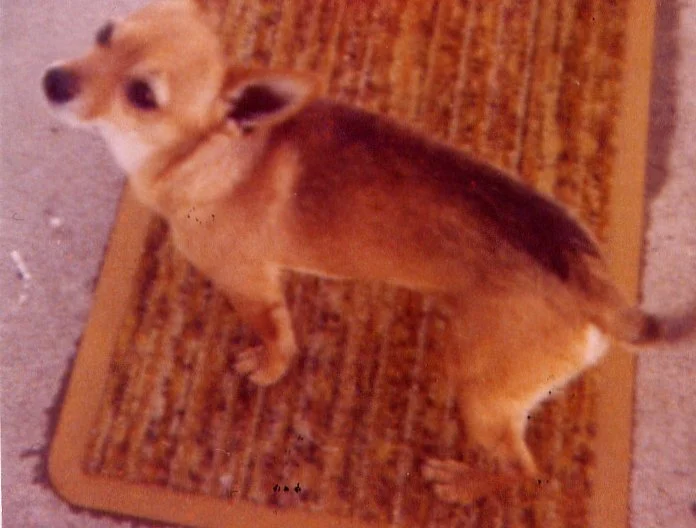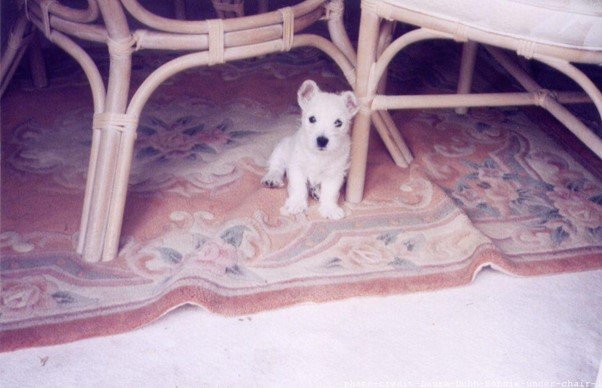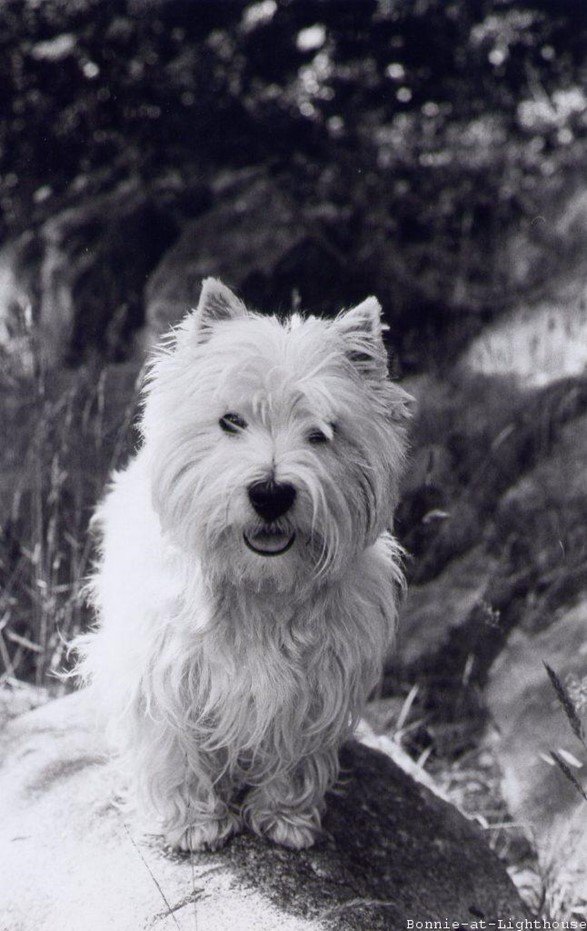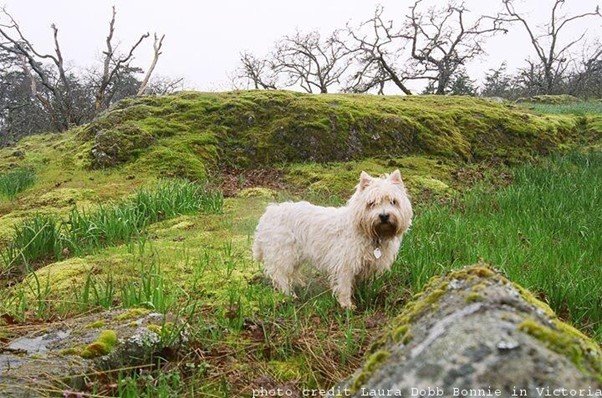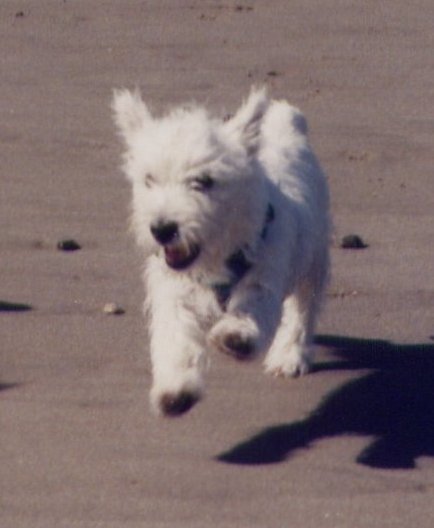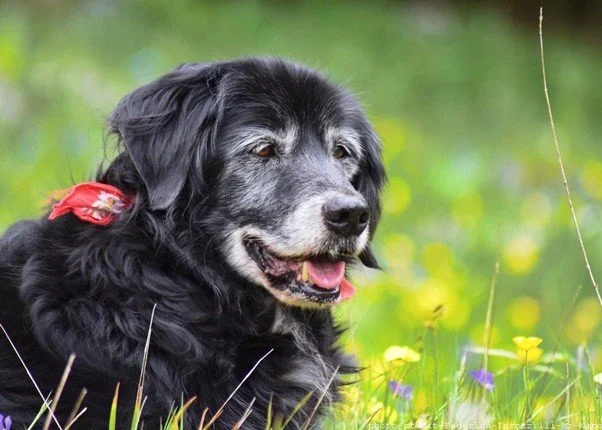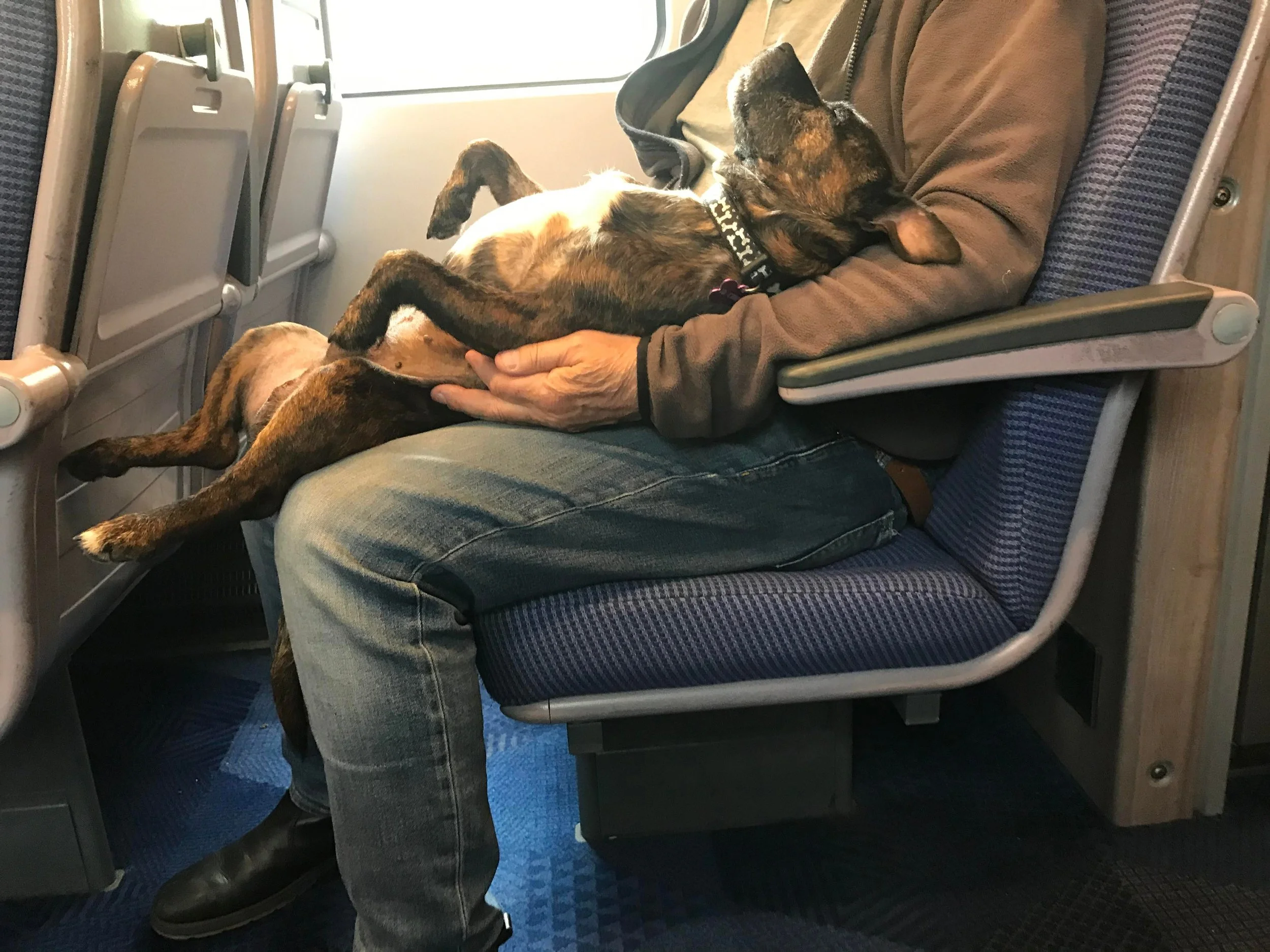‘Slow Grief’
I haven’t lost a dog since Easter Monday 2018. Before that, it was February 2013. Both were Scottish terriers – one a Cairn and one a Westie. They both died in my arms of all system failure. They passed in the wee hours with no medical intervention. Nash, our Cairn, was on heart medication. They didn’t want to rush to the vet in the middle of the night – they went fast. Bonnie had been our dog from a pup and had lived in three countries with us. She left us at almost 17 years of age. She was healthy her entire life and died of natural causes. Nothing is good about it. Death is part of life.
I once posted an old photo of our dog, Nash (the Cairn) on Facebook. He was an ex-breeding dog from a puppy farm. We adopted him when he was seven years old from Many Tears Animals Rescue in Wales. When we learnt about Nash’s bad teeth, when we adopted him, we didn’t know until later that this meant his heart was bad. Born with congenital heart weakness, he died of congestive heart failure. Like my Father did in 2015. When you adopt a dog with health issues, you try to make their life beautiful and healthy. You don’t dwell on the issue. At least we didn’t. It does not make it any easier when they leave you.
photo credit Laura Dobb
When I posted that photo of Nash on a UK Cairn Terrier group, the response was immense! I know none of the people in this group but felt like sharing a photo of my boy, Nash, RIP. Four hundred and thirty-seven people interacted with the post and seventy-nine wrote personal messages to me! Many left sayings, poems and spoke of their own lost Cairn. When my Mother passed away last year, only sixty-four people engaged. Forty-six people left comments – and these are my Facebook friends! My Mum was a lovely person, that’s not it. It’s the fact that people grieve deeply over dogs.
In this blog, I will talk about all the elements of grief (we feel) over a beloved dog. And about Slow Grief – the grief that takes time to process, and sometimes, never leaves us at all.
When grieving the loss of my Mum, one year after her passing, in 2020, I couldn’t walk, I was exhausted. Sad doesn’t even come close. I made notes for this blog for months. I wrote another blog post altogether because this one wasn’t complete. This blog was also been published in the Pet Dog Trainers of Europe January 2021 Newsletter. Because of grief, for my Mum, I wasn’t ready to give this subject the attention it deserved. Ironic but true.
Grieving for my Mum, brought back all the grief I had in the past for the dogs who have left my life. I grieved for my first dog, Muffin, when I left Canada for the UK in 1984. I missed him more than my Mum at the time. I cried into my pillow for many nights in my new ‘digs’. I was working in a Cotswold village B&B. When my Mum told me he had passed away, I blamed her. When I had seen photos of Muffin, he had gained a lot of weight for a Chihuahua cross JRT. My Mum had tried to convince me to give him away to an old lady in West Vancouver because Mum was moving to South Africa. I refused and said I would come home to look after my dog. It was then that he died. I felt so much regret and guilt. I was young, and at nineteen, should have been exploring the world. But my heart was with my dog. I was too late. I lost him. I still remember everything about him. The way his hair felt when I stroked him, his bright eyes and his little foot pads. He left me thirty-five years ago.
My little dog, Muffin
I don’t think about him every day anymore. But when I do, there is love. When we allow our hearts to feel the grief – to ‘wallow’, it is healthy. It’s like a peat fire or a bit of hardwood in the wood burner of the heart. We experience emotion and process it in the time that feels right for us. Slow Grief is to allow the time for all the feelings losing a dog (or human) can bring. If you have a friend who has lost a dog, ‘Do NOT impose a timeline for feeling better – there is no timeline for grief.’[i]
When we lost Bonnie, our Westie, I cried on and off for three months. I definitely ‘wallowed’ in grief. I felt as if I had frozen my diaphragm because I cried so much. My son is almost twenty now – so seventeen is a long time to be close to a sentient being, human or dog. I slept on Bonnie’s bed, I lit candles every night, I wrote poetry and held a wake after a couple of weeks. It was early March in London and it was cold! About fifteen people came and shared single malt whiskey, tea and shortbread with us for about three hours. I displayed photos of Bonnie, heather plants and candles to honour her. I even shared my soppy poems. It felt good to do this and cathartic. It says alot about people relating to the death of a dog, that fifteen folks would show up in a London Rec on a cold March day.
Reflecting over your life with your lost dog is a natural and positive thing to do. Pour over photos, sit with loved ones and remember your dog. Or sit alone and write down beautiful memories of your best friend. When you do this, you are healing your loss. You can do these positive things alongside feeling the pain of grief. But with the pain, let it run loose – don’t try to shape it.[ii] Mourning need not be a creative exercise. It doesn’t need to be a ‘scrapbook’ experience. My ruminating over Bonnie gave me a certain ‘freedom’ in the end. I miss her to this day, but I am not in pain anymore.
Moments before Bonnie died in my arms, in a panic, we felt it necessary to find an emergency vet. She was almost gone so it was futile. My brain didn’t work, nor my fingers when I tried to use my laptop to find where we could go at three in the morning. Immediately after, I was holding my Bonnie and she was gone. I sat in the car and we went to the emergency vet anyways.
We sped towards Richmond (we lived in Chiswick), along Thames Road. We were all wailing in grief. I said to my husband, ‘Just drive into the Thames’ and my son yelled from the back ‘No Mum, I don’t want to die!’ He was ten years old. Poor guy. That is very macabre and actually quite funny to me now. But we go crazy when we lose our loved ones.
We had handed Bonnie’s body to the lovely Scottish veterinarian and went home to share ½ a bottle of Whiskey. We cried until we fell asleep. It was not a pleasant sleep as we missed Bonnie’s warmth between us. Our hearts broke that night.
Bonnie was our ‘first born’ we joked. My husband worked at night so that he could be at home with her during the day when I was at my office job. As time went on, we took her to each of our jobs. One beautiful summer’s evening with Bonnie, I was sitting in a local park. An older man came over and told me I should have a real baby. Bonnie was being a dog, beside me. He was wrong. My bond with my dog was so deep and real. I did have a human child seven years later. Henry was my second ‘child’!
It’s been ten years since Bonnie left us and I still haven’t given away or gotten rid of her leash, coat or blanket. It smells like ‘old dog’ and any feng shui person would tell me to throw them away. When she was younger, we used to say that her feet smelt like ‘soda crackers’ and her head like watermelon. I have a silver heart shaped ‘dog tag’ pendant that I wear. It says ‘cracker feet’ and ‘Bonnie’ on one side and ‘Maist Michty’ on the other side. ‘Maist Michty’ is the Scottish dialect from Greyfriar’s Bobby meaning ‘Most extraordinary’. We become very intimate with our dogs. We spend as much time with them as we do our partners. Or more? Is it any wonder that we grieve for so long? Try and read Eleanor Stackhouse Atkinson’s, ‘Greyfriar’s Bobby’. Or watch the film, the older version.
I would like to share with you, some of the raw emotions I experienced when Bonnie died. I haven’t read these pages torn from my 2013 diary for some time and they still give me a lump in my throat. I am a paper ‘pack rat’ for good reason. This makes me realise that even though I miss my Mum, I haven’t written a word in my diary, nevermind poetry.
Written in my diary, the day Bonnie died 27th February 2013:
Our beloved Bonnie died near midnight of this day – may she chase rabbits and squirrels in the fields of heaven until we can do our special family whistle and welcome her in our arms once again.
The day after Bonnie died, 28th February 2013, I wrote:
Warmer day – damn Spring – why didn’t it come earlier for Bon. Crying all day, my skin feels on fire. I am hollow, everything is flat, my heart feels broken – literally, a pain in my chest. I can barely lift my limbs. I can’t smell because I have cried too much. My impulse is to write, emails, FB and phone my Mom – to let out feelings, share the pain and to reach out to family and friends – but I can only talk to my Mom. At 02:37 I get up and drink water, write and call Allison [sister in California]. Hot milk and back to bed at 04:20 am. I am mad at the birds for not singing when Bonnie was still here. I don’t sleep very well.
There is no right way or wrong way to grieve. It’s not helpful to bottle it up because then, it may make you ill in some way – there needs to be some sort of release. Grief is personal. Grief is subjective. Grief is universal. You can bury grief. Often, your grief is often uncomfortable to others. Other people can even hijack your grief. If this happens, you may feel like keeping it closer to you again – returning to the private experience of your loss.
Diary entry, 1st March 2013:
I go to Spitalfields but can barely walk and I cry when alone. I can talk to others but feel brittle and am exhausted when I come home. My body still feels empty/gutted. I care not for the world, without Bonnie. Brett and I talk about our guilt over not being Bonnie’s advocate with the vet in her last days. I go to bed very sad but sleep okay.
It feels like Bonnie’s spirit has left our house a bit. I reach out to find her and I can’t and this is distressing to me.
The day that Bonnie had died, she had had trouble breathing that morning. We had taken her to the vet, and he had prescribed some allopathic medicine that may help her. I asked him what the side effects were, and he said anxiety and a worsening of the situation. In retrospect, I wish we had never given her that medicine. She rarely had pharmaceuticals. She suffered from the side effects on her last day on the planet. She died from natural causes, but with added anxiety from those pills. Poor girl. Still, there is no point in going over the guilt. What we can do is learn from these doubts and be more of an advocate for our next dog.
Diary entry, 3rd March 2013:
Too much room on the bottom shelf of the fridge where your meat used to be. I save the last mouthful of oatmeal [porridge] and remember you’re not here to eat it. Empty bed, empty bowl. Empty passenger seat . Leash with no pull. No begging at mealtimes. No sound of your nails on the floor. I can wear black now, no white hairs – oh for your mark on me! What do I do on Monday when Brett goes to work? Walk, all I can do. I can’t be here. Every song on the radio reminds me of you, my girl.
When we drop food accidentally on the floor at mealtimes, no rush not to pick it up. My midnight yogurt [snack] buddy is gone. You’re the reason that Brett could join the Chris Evans breakfast club [on Radio 2] And besides all these trivial things, our reason to be… you shaped our lives, the rhythm of our days, with the clink of your food bowl, the tinkling of your leash and tags being the hands [of a clock] ticking.
I conclude my own Westie grief with this poem. I wrote it and posted it on the local Rec fence to announce Bonnie’s wake in London. The corniness of it makes me wince a bit now but I was completely devastated:
photo credit Laura Dobb
After Bonnie died that February 2013, my son and I went to Canada in June. Brett followed us and we spread her ashes in her favourite West Vancouver stream. I had planned to scatter rose petals along with the ash in this little river. Like the macabre scene of us driving along the Thames, the scattering of ashes did not go as planned either. If you know anything about mammal ashes, well, they are heavy! I had not experienced this lesson in physics before. The roses went sailing down the river and the ash soon sunk to the bottom. Another tragi-comedy. And that wasn’t the only crazy thing that happened around Bonnie’s passing.
The author Emile Zola said:
‘Can’t you see, an animal’s death
is something very special. But,
obviously it cannot touch or affect anyone else other than the
one who loved it.’
We went to view Bonnie’s body at the crematorium. This was more for Brett than myself, as he had not come to terms that she was actually gone. It was a very impersonal and odd time. I did not enjoy seeing the giant smoke stack as we approached the building. The ‘Pet Remembrance Garden’ outside was sad and tasteless. As we entered the building on the outskirts of London, there was no one but a recorded voice to greet us. It told us to have a seat. No one else was in the waiting room. We sat and looked at their book of pet remembrance. As we sat in this room, we could see Bonnie’s name (spelled wrong) on a TV, above the door. The time came for us to enter the viewing room and I followed Brett into a dark room with a table inside. A woman who worked for the crematorium stood by Bonnie’s body. Our beloved dog smelled like disinfectant.
When I touched her, there was no lifeforce – she felt like a carpet. Brett started crying. I asked the woman if Bonnie had rigor mortis and she said that that stage had already passed. Now, she said, Bonnie’s limbs were quite bendable – and she started to bend them back and forth! Oh my God, I was completely shocked. At the same time, the craziness of the situation made Brett and I laugh afterwards. Death, as in life, is never simple. We gave Bonnie a beautiful wake and scattered her ashes.
We still have Nash’s ashes. We had no wake for him. We haven’t found the right place yet. I once saw a woman hold a public wake in our local park in East Vancouver. She had made a sort of ‘grotto’ with sheets hanging from trees, to make a kind of tent. She had candles burning, photos of her dog on the ‘walls’ of the grotto and a pile of toys to give away to dog friends. She was talking to all the people and dogs who came into her mourning tent cave, her altar to her dead dog. It was very touching.
The point is to do what is right for you, in your own time. You will know what feels appropriate. In ‘How to Make an Old Dog Happy’ by Olivier Lagalisse, it says that some people still have their dogs taxidermied. I remember seeing this a few times when I was growing up, in Canada. But Canadians, hunters, seemed to do this a lot back then. It is not to my taste, but who is to judge? I wish that we could have buried Bonnie on our land in Canada or spread her ashes there. Being in a city, without land, people may have to be more creative than Brett and I at the crematorium.
On the Isles of Scilly, there is an unofficial animal cemetery on the edge of a stunning beach. Tall dune grass surrounds the little graves. Families have made driftwood headstones with jars of flowers as decoration. In the end the details about burial and ashes are important. But they are not the most lasting and poignant feelings that remain. They are a marker of a life you wish to remember. They can offer a place to return to pay your respects.
photo credit Federica Iacozzilli
There are many articles online, guides to coping with the loss of a dog and they can be helpful. This article is to speak of the beauty of allowing grief to be public and ‘out there’ and to let this be any length of song. This is an example of such public sorrow. A cathartic ode.
Federica Iacozzilli gave me permission to share her writings about her dog Mr. Nano, whom she lost in June 2020:
Vivere senza di te non sarà facile.
Mein Engel, mein Ich, mein Alles.
Torna presto.
Living without you won’t be easy.
My angel my me my everything
Come back soon.
Being close to someone silently
with constancy and delicacy, there is enormous dignity.
My heart, my heart.
Today marks a week you’ve been gone,
MrN…
You left everyone in the void, we’re all disconnected and disconnected, untied where
before there was unity and cohesion.
Franco is very angry you know…
I think I underestimated how close you
really were.
He’s in the shoes of the man of the house,
not that I put them on him, and I think
this role really scares him. You were there,
before, to adjust everything… even with
your presence. Sometimes he just changes
his expression and leaves to be alone. I try
to lift it up a bit, but I’m not too capable of
it. You knew how to do it right, you
Lilli looks pulled, tired… sometimes she looks at me with those
dark, liquid eyes, who almost seems to want to ask me why all this
happened. You know that she’s not one to open yet, since you’re
not there, I can see it in her face.
I know it’s going to take time, but for now it all sucks.
I miss you so much, Mr. Nano, I miss you so much…
This morning I found all the mole [more] of how much I miss you.
We think it’s better, because we get used to the deafening and brutal absence, because we get into a new routine, made of new things
and new spaces. But nothing is enough.
A walk with one of the others is enough, through the dark streets at
dawn in the morning, because the absence fills up like a boulder.
Remembering how much you liked to go out on the street when no
one was there yet, how much you liked to play on your deafness
(selective, very selective) to have the excuse to look at me and leave
on your own business.
I don’t think you’ll ever get used to the terrible devouring black hole
that leaves such a great absence. Never. Never. Anyway, Mr. Nano,
you always accompany me one way or another. #MrN
Thank you, Federica for sharing your heartfelt, beautiful, and even joyful words about Mr Nano.
photo credit Laura Dobb ‘Monty & Roy’
Whether we lose rescue dogs or dogs we have known from a pup, they weave themselves into our very being. With their pure essence. Their generosity of spirit. Their trust or even their initial distrust. They often teach us how to be better guardians, and better people. So much unspoken time with dogs, by our side, gets under our skin. When they are gone, we see them – phantom sightings. We mark time by the day, week, month, year – the ebb and flow of grief throughout the first year. In the first year and beyond, we may be touched by something unexpected, into a sudden feeling of the loss anew. A burst of tears or anger may arise.
The idea of Slow Grief is to allow yourself time and space to feel everything. To wallow in the grief. Name it with words. At the same time, celebrate your lost friend by remembering all the stories. Look at photos, create art, poems, and honour the way they filled your life with purpose beyond the daily walk. When we slow down and go into the emotions around death, instead of tidying it away, we will suffer less in the end. Our pain will transform, over time, into a melancholy or longing. Not that having no sadness is the goal. In years to come, we may see a photo and be able to smile without looking to the floor first.
Stay tuned to The Slow Dog Movement ‘SLOW talk’ blog for more ideas. Join me in creating a sea change – an evolution revolution for dogs. Where ‘less is more’ and seeing things from a dog’s point of view makes life easier for you too!
Bibliography
Harding, D.E. The Little Book of Life and Death. London, Arkana, 1988
Lagalisse, Olivier. J’aide mon chien à bien vieillir. How to Make an Old Dog Happy.Translated by Elfreda Powell. London, Souvenir Press, 2005
Porter, Max. Grief is the Thing With Feathers. London, Faber and Faber, 2015
[i] https://www.vetmed.wsu.edu/outreach/pet-losshotline/support-for-bereaved/dos-and-don’ts
[ii] https://www.psychologytoday.com/gb/blog/ animal-attachment/201702/7-self-care-essentialswhile-grieving-the-death-pet



